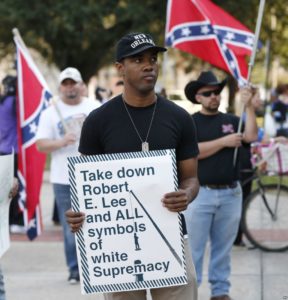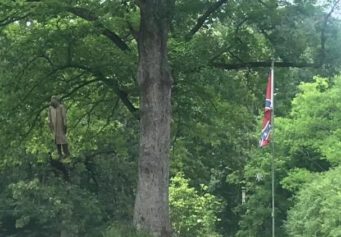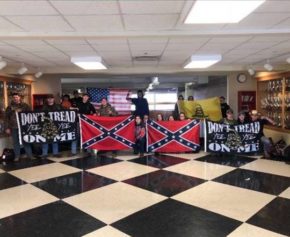
In this Dec. 10, 2015 file photo, an unidentified participant holds a sign during a rally lead by the Take ’em Down Coalition, as confederate heritage supporters bear confederate flags nearby in front of City Hall in New Orleans. GERALD HERBERT, AP
In the old Confederacy, traditions die hard. And this certainly holds true for the symbol of slavery, white supremacy and domestic terrorism, at a time when some yearn for the good old days when Black people were put in their place. The latest chapter in the saga of Confederate symbolism is playing out in New Orleans, where the planned removal of rebel monuments is turning ugly and violent.
As the Associated Press reported, on December 17 the majority-Black New Orleans city council voted 6-1 to approve Mayor Mitch Landrieu’s plan to remove Confederate monuments of General Robert E. Lee, P.G.T. Beauregard and Jefferson Davis. Mayor Landrieu, who is white and has received strong Black support, proposed that the monument be taken down. White backlash to the plan, however, has been substantial, with intimidation and death threats. A contractor, H&O Investments LLC of Baton Rouge, was hired to remove the monuments, but they bowed out after protesters with affiliations to white supremacist groups visited the firm’s workers on site as they were taking measurements. The owner’s Lamborghini was set on fire outside his Baton Rouge office, and the company received death threats and were threatened with cancelled contracts. Once H&O pulled out of the contract and the city accepted bids, companies that expressed interest received denunciatory phone calls and emails from Save Our Circle, a group that is fighting to keep a massive 1884 monument to General Lee in Lee Circle.
“There is no doubt that there is a huge amount of rage over the attack on Confederate symbols,” Mark Potok with the Southern Poverty Law Center told AP. According to the Montgomery, Alabama-based civil rights group, which tracks hate group activity across the country, there have been around 360 pro-Confederate flag rallies throughout the U.S. since the June 2015 Charleston, South Carolina massacre. Prior to the deadly act of domestic terrorism — in which a white supremacist named Dylann Roof gunned down nine Black congregants at Emanuel AME Church — such rallies were a rare occurrence.
“The Civil War was a violent, treasonous campaign of terror to preserve slavery and white supremacy; white terror and domination continued after the Civil War,” SPLC says on its website in opposition to the Confederate symbols remaining in New Orleans. “The monuments at issue in this case honor and glorify the Southern Confederacy. Therefore, it is with the Confederacy that this analysis must begin.”

Confederate monument supporters waved confederate flags at the statue of Confederate General P.G.T. Beauregard on Sunday January 17, 2016. (Photo by Kathleen Flynn, NOLA.com l The Times-Picayune)
As SPLC notes, Louisiana representatives, and the Confederate Constitution, identified slavery as the reason for secession.
“As respected Louisiana federal jurist Judge John Minor Wisdom pointed out over fifty years ago, Louisiana social history is rooted in ‘the dominant white citizens’ firm determination to maintain white supremacy in state and local governments by denying to Negroes the right to vote.’ ”
New Orleans, with a long and complicated history around race, has been no stranger to such flashpoints in history. After all, this city gave birth to the infamous Plessy v. Ferguson case, in which the U.S. Supreme Court made “separate but equal” the law of the land in 1896, upholding racial segregation in public accommodations. Homer Plessy, a Black man who could have passed for white, boarded a whites-only railroad car and was arrested under the Separate Car Act. Further, Ruby Bridges, the first Black child to attend an all-white elementary school in the South and the subject of a Norman Rockwell painting, lived in New Orleans. And as AP noted, the city has witnessed struggles over the integration of the Mardi Gras parades.
Meanwhile, the federal courts have inserted themselves into the debacle over the Confederate monuments, as the Times-Picayune reported. The U.S. 5th Circuit Court of Appeals issued an order Friday morning preventing the city of New Orleans from taking down the monuments until a federal lawsuit challenging the plan is resolved. The Monumental Task Committee, the Louisiana Landmarks Society, the Foundation for Historical Louisiana, and Beauregard Camp No. 130 claim the city violated the U.S. and Louisiana constitutions when it declared the Confederate statues of Robert E. Lee, Jefferson Davis and P.G.T. Beauregard were public nuisances.
“We appreciate the unanimous decision of the panel of federal judges, which acknowledges that removing the monuments is premature. This action will allow for a full review of the constitutional and statutory issues at stake in this case,” Pierre McGraw, president of the Monumental Task Committee, said in a statement.
There is a similar case in state court, according to the Times-Picayune. New Orleans Civil District Judge Piper Griffin ruled last month that the Monumental Task Committee, volunteers who maintain and repair the monuments around the city, cannot claim ownership of the structures. Expecting a state appellate court defeat, Confederate supporters hope to bring the case to the Louisiana Supreme Court for a ruling on the constitutionality of the city’s removal of the statues.


